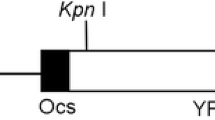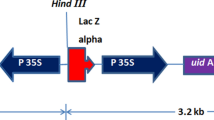Abstract
In this paper we describe the production of transgenic broccoli and cauliflower with normal phenotype using an Agrobacterium rhizogenes-mediated transformation system with efficient selection for transgenic hairy-roots. Hypocotyls were inoculated with Agrobacterium strain A4T harbouring the bacterial plasmid pRiA4 and a binary vector pMaspro::GUS whose T-DNA region carried the gus reporter gene. pRiA4 transfers TL sequences carrying the rol genes that induce hairy root formation. Transgenic hairy-root production was increased in a difficult-to-transform cultivar by inclusion of 2,4-D in the medium used to resuspend the Agrobacterium prior to inoculation. Transgenic hairy roots could be selected from inoculated explants by screening root sections for GUS activity; this method eliminated the use of antibiotic resistance marker genes for selection. Transgenic hairy roots were produced from two cauliflower and four broccoli culivars. Shoots were regenerated from transgenic hairy root cultures of all four cultivars tested and successfully acclimatized to glasshouse conditions, although some plants had higher than diploid ploidy levels. Southern analysis confirmed the transgenic nature of these plants. T0 plants from seven transgenic lines were crossed or selfed to produce viable seed. Genetic analysis of T1 progeny confirmed the transmission of traits and revealed both independent and co-segregation of Ri TL-DNA and vector T-DNA. GUS-positive phenotypically normal progeny free of TL-DNA were identified in three transgenic lines out of the six tested representing all the cultivars regenerated including both cauliflower and broccoli.
Similar content being viewed by others
References
Berthomieu P. and Jouanin L. 1992. Transformation of rapid cycling cabbage (Brassica oleracea var. capitata) with Agrobacterium rhizogenes. Plant Cell Rep. 11: 334–338.
Boulter M.E., Croy E., Simpson P., Shields R., Croy R.R.D. and Shirsat A.H. 1990. Transformation of Brassica napus L. (oilseed rape) using Agrobacterium tumefaciens and Agrobacterium rhizogenes: a comparison. Plant Sci. 70: 91–99.
Christey M.C. 1997. Transgenic crop plants using Agrobacterium rhizogenes-mediated transformation. In: Doran P.M. (ed.), Hairy Roots: Culture and Applications. Harwood, Amsterdam, pp. 99–111.
Christey M.C. and Sinclair B.K. 1992. Regeneration of transgenic kale (Brassica oleracea var. acephala), rape (Brassica napus) and turnip (Brassica campestris var. rapifera) plants via Agrobacterium rhizogenes-mediated transformation. Plant Sci 87: 161–169.
Christey M.C., Sinclair B.K., Braun R.H. and Wyke L. 1997. Regeneration of transgenic vegetable brassicas (Brassica oleracea and B. campestris) via Ri-mediated transformation. Plant Cell Rep. 16: 587–593.
David C. and Tempé J. 1988. Genetic transformation of cauliflower (Brassica oleracea L. var. botrytis) by Agrobacterium rhizogenes. Plant Cell Rep. 7: 88–91.
Doyle J.J. and Doyle J.L. 1990. Isolation of plant DNA from fresh tissue. Focus 12: 13.
Earle E.D., Metz T.D., Roush R.T. and Shelton A.M. 1996. Advances in transformation technology for vegetable brassica. Acata Hort. 407: 161–168.
Gelvin S.B. and Liu C.-N. 1994. Genetic manipulation of Agrobacterium tumefaciens strains to improve transformation of recalcitrant plant species. In: Gelvin S.B. and Schilperoort R.A. (eds.), Plant Molecular Biology Manual. Kluwer Academic Publishers, Dordrecht/Boston/London, pp. B4: 1–13.
Hamill J.D., Rounsley S., Spencer A., Todd G. and Rhodes M.J.C. 1991. The use of the polymerase chain reaction in plant transformation studies. Plant Cell Rep. 10: 221–224.
Hatamoto H., Boulter M.E., Shirsat A.H., Croy E.J. and Ellis J.R. 1990. Recovery of morphologically normal transgenic tobacco from hairy roots co-transformed with Agrobacterium rhizogenes and a binary vector plasmid. Plant Cell Rep. 9: 88–92.
Hosoki T. and Kigo T. 1994. Transformation of Brussels sprouts (Brassica oleracea var. gemminifera Zenk) by Agrobacterium rhizogenes harboring a reporter, β-glucuronidase gene. J. Jpn. Soc. Hort. Sci. 63: 589–592.
Hosoki T., Shiraishi K., Kigo T. and Ando M. 1989. Transformation and regeneration of ornamental kale (Brassica oleracea var. acephala DC) mediated by Agrobacterium rhizogenes. Scient. Hort. 40: 259–266.
Hosoki T., Kigo T. and Shiraishi K. 1991. Transformation and plant regeneration of broccoli (Brassica oleracea var. italica) mediated by Agrobacterium rhizogenes. J. Jpn. Soc. Hort. Sci. 60: 71–75.
Hosoki T., Kanbe H. and Kigo T. 1994. Transformation of ornamental tobacco and kale mediated by Agrobacterium tumefaciens and A. rhizogenes harboring a reporter, β-glucuronidase (gus) gene. J. Jpn. Soc. Hort. Sci. 63: 167–172.
Jefferson R.A. 1987. Assaying chimeric genes in plants: the GUS fusion system. Plant Mol. Biol. Rep. 5: 387–405.
Jefferson R.A., Kavanagh T.A. and Bevan M.W. 1987. GUS fusions: β-glucuronidase as a sensitive and versatile gene fusion marker in higher plants. EMBO J. 6: 3901–3907.
Metz T.D., Dixit R. and Earle E.D. 1995. Agrobacterium tumefaciens-mediated transformation of broccoli (Brassica oleracea var. italica) and cabbage (B. oleracea var. capitata). Plant Cell Rep. 15: 287–292.
Moore L., Warren G. and Strobel G. 1979. Involvement of a plasmid in hairy root disease of plants caused by Agrobacterium rhizogenes. Plasmid 2: 617–626.
Murashige T. and Skoog F. 1962. A revised medium for rapid growth and bioassays and toabacco tissue culture. Physiol. Plant. 15: 437–497.
Nilsson O. and Olsson O. 1997. Getting to the root: the role of the Agrobacterium rhizogenes rol genes in the formation of hairy roots. Physiol. Plant. 100: 463–473.
Ockendon D.J. 1988. The ploidy of plants obtained from anther culture of cauliflowers (Brassica oleracea var. botrytis). Ann. Appl. Biol. 113: 319–325.
Poulsen G.B. 1996. Genetic transformation of Brassica. Plant Breed. 115: 209–225.
Puddephat I.J., Riggs T.J. and Fenning T.M. 1996. Transformation of Brassica oleracea L: a critical review. Mol. Breed. 2: 185–210.
Reed K.C. and Mann D.A. 1985. Rapid transfer of DNA from agarose gels to nylon membranes. Nucl. Acids Res. 13: 7207–7221.
Senior I., Holford P., Cooley R.N. and Newbury H.J. 1995. Transformation of Antirrhinum majus using Agrobacterium rhizogenes. J. Exp. Bot. 46: 1233–1239.
Sharpe A.G., Parkin I.A.P., Keith D.J. and Lydiate D.J. 1995. Frequent nonreciprocal translocations in the amphidiploid genome of oilseed rape (Brassica napus). Genome 38: 1112–1121.
Tempé J. and Casse-Delbart F. 1989. Plant gene vectors and gentic transformation: Agrobacterium Ri plasmids. In: Vasil I.K. (ed.), Cell Culture and Somatic Cell Genetics of Plants. Academic Press, London, p. 25–49.
Tepfer D. 1990. Genetic transformation using Agrobacterium rhizogenes. Physiol. Plant. 79: 140–146.
Toriyama K., Stein J.C., Nasrallah M.E. and Nasrallah J.B. 1991. Transformation of Brassica oleracea with an S-locus gene from Brassica campestris changes the self-incompatibility phenotype. Theor. Appl. Genet. 81: 769–776.
Visser R.G.F., Jacobsen E., Witholt B. and Feenstra W.J. 1989. Efficient transformation of potato (Solanum tuberosum L.) using a binary vector in Agrobacterium rhizogenes. Theor. Appl. Genet. 78: 594–600.
Webb K.J., Robbins M.P. and Mizen S. 1994. Expression of GUS in primary transformants and segregation patterns of GUS, TL-DNA and TR-DNA in the T1 generation of hairy root transformants of Lotus corniculatus. Transgenic Res. 3: 232–240.
Author information
Authors and Affiliations
Rights and permissions
About this article
Cite this article
Puddephat, I., Robinson, H., Fenning, T. et al. Recovery of phenotypically normal transgenic plants of Brassica oleracea upon Agrobacterium rhizogenes-mediated co-transformation and selection of transformed hairy roots by GUS assay. Molecular Breeding 7, 229–242 (2001). https://doi.org/10.1023/A:1011338322000
Issue Date:
DOI: https://doi.org/10.1023/A:1011338322000




